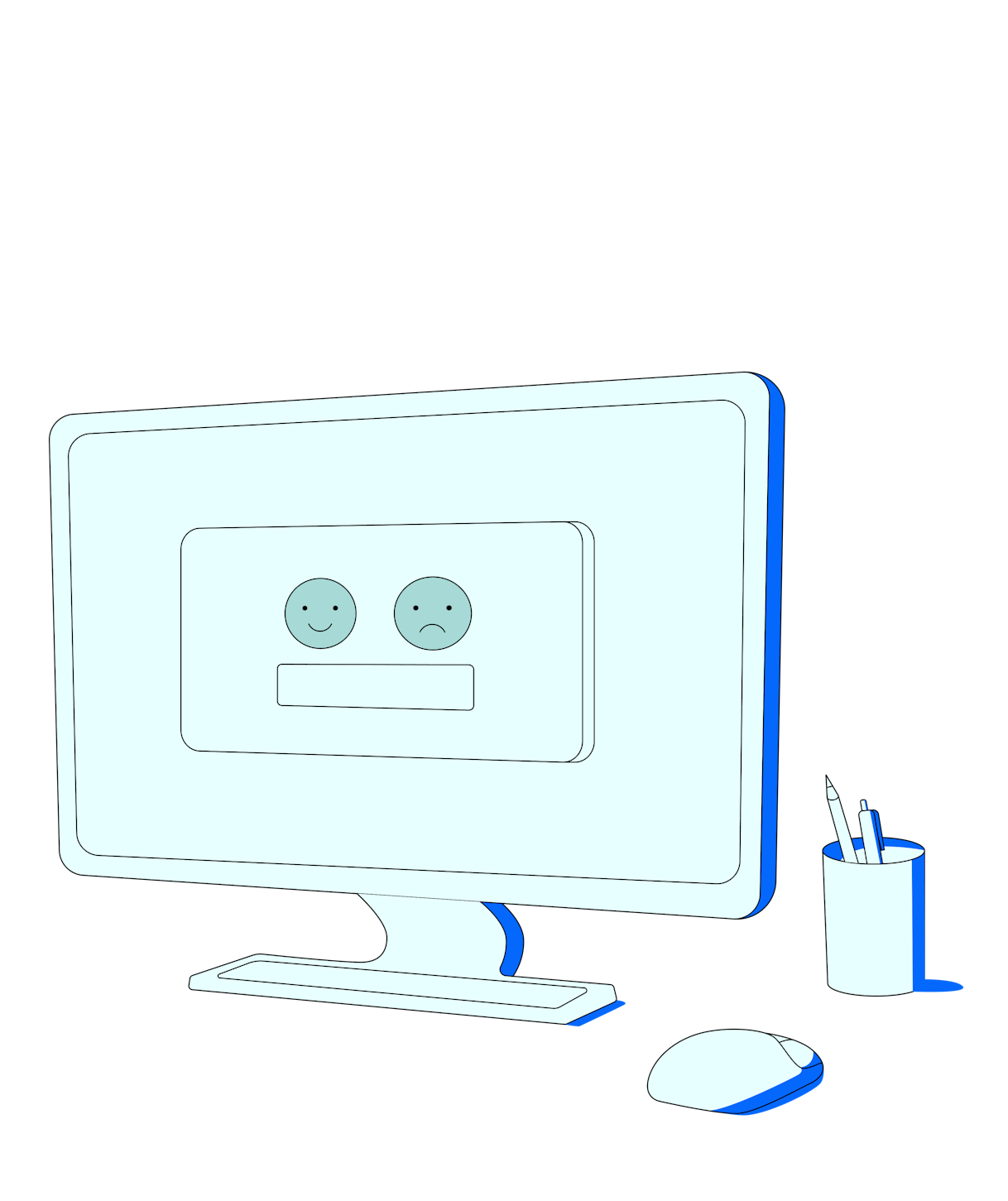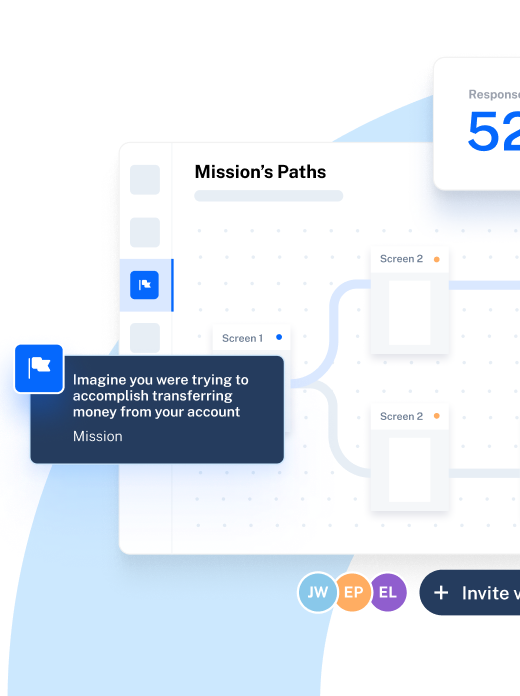How was your last experience with your favorite brand?
[ ] Great
[ ] Good
[ ] Neither good nor bad
[ ] Bad
[ ] Terrible
We’re not going to hold you to your answer—or make you tell us who your favorite brand is—but consider how recently you filled in a survey like this. It only takes a moment, but the insights provided to the team behind the survey are vital in shaping customer experience.
Customer experience surveys are how you get a pulse on what your customers think and feel about their experience with your brand. From first contact to final goodbyes, customer experience surveys are crucial for understanding customer wants, needs, pain points, and journeys.
You can use the insights you collect from customer experience surveys to inform decision-making across your organization, improve your customer experience strategy, and build products and experiences that customers can’t help but love. (Spoiler: it’s because their feedback helped guide design and development.)
In this article, we’ll examine what customer experience surveys are, the different types you can use, and how to create surveys that uncover eye-opening insights. We’ll finish up with three customer experience survey templates to kickstart your feedback collection process.
Understanding customer experience surveys
A customer experience (CX) survey is a research method for collecting feedback from customers about their experience with your company across multiple touchpoints. They help you gain insight into what customers think and feel about your product by asking questions about their experience, preferences, satisfaction levels, and issues.
Unlike user interviews, CX surveys are unmoderated, meaning customers complete them on their own. You simply create your CX survey, distribute it, and wait for the results to roll in before starting analysis.
One crucial thing to note is the difference between customer experience surveys and user experience surveys. While the two are similar, CX surveys look at the entire customer experience, whereas UX surveys focus specifically on getting product-related insights, assessing usability, and understanding a user’s experience within your product.
So, with that distinction, let’s take a look at what makes customer experience surveys worth doing.
Why use CX surveys in user research?
CX surveys in user experience research are one of the most direct and versatile methods for collecting the customer feedback you need to improve overall customer experience. Whenever you need to check in (which you should be doing often) with what your customers think or feel about your brand, product, or service, a CX survey is a simple and efficient UX research method for getting the feedback you need.
Here are some of the benefits of CX surveys in user research:
- They guide your customer experience strategy: CX surveys help understand what’s working and what isn't when it comes to your customer experience initiatives, giving you the insights you need to proactively improve customer experience
- They inform decision-making for customer-centric development: The insights you collect from CX surveys can help you make insight-informed decisions across your organization—be it in the Product team or Sales team
- They help benchmark CX levels over time: You can use the data collected to set and measure customer experience metrics and KPIs to benchmark your CX success
The outcome? Greater customer satisfaction, loyalty, and retention. When you gather feedback and act on insights, you not only build better CX for customers, but you also affirm to customers that you care about their experience. You tell them, “Your experience matters to us, and we care about your satisfaction and success”.
Types of customer experience surveys to try
CX surveys are versatile—with different types of surveys able to collect different types of feedback.
Your chosen CX survey type will dictate the kinds of research questions you ask. While rating scales are a popular customer experience question type, you can get extra context and deeper insights by adding open-ended questions to the mix. Doing so ensures you get both quantitative and qualitative data.
Before we run through three popular types of CX surveys, we want to make one thing clear: a CX survey is any survey that gets you insights on customer experience. That might be these survey types, or it may be a custom-built survey with unique questions on exactly what you’re researching.
Don’t feel confined to a specific type of survey or question—you know what you’re looking to understand, so build the survey that helps you find it.
Customer satisfaction survey (CSAT)
As the name suggests, customer satisfaction surveys help you understand how happy or unhappy customers are with your CX.
CSAT surveys help you better understand customer needs and expectations, enabling you to optimize your CX in line with what customers want. Conducting these surveys enables you to calculate a customer satisfaction score, which you can use to benchmark customer satisfaction.
Lke any survey, a CSAT survey only gets the right insights if you ask the right questions. Read on for sample questions to try out.
Customer satisfaction survey question examples
CSAT survey questions ask users about their level of satisfaction with CX, which means they’re often in the form of Likert scale questions. These involve asking a question and providing answer options to choose from—typically presented on a scale. For example:
- “How satisfied or dissatisfied are you with your experience with our product/service?”
- “How satisfied or dissatisfied are you with the assistance our customer service team provided?”
- “How satisfied or dissatisfied are you with the quality of the product/service?”
- “Considering the price you paid, how satisfied or dissatisfied are you with the value you received from our product/service?"
You then provide possible answers to users based on the question you’ve asked. Check out this helpful collection of Likert scales to offer to respondents:
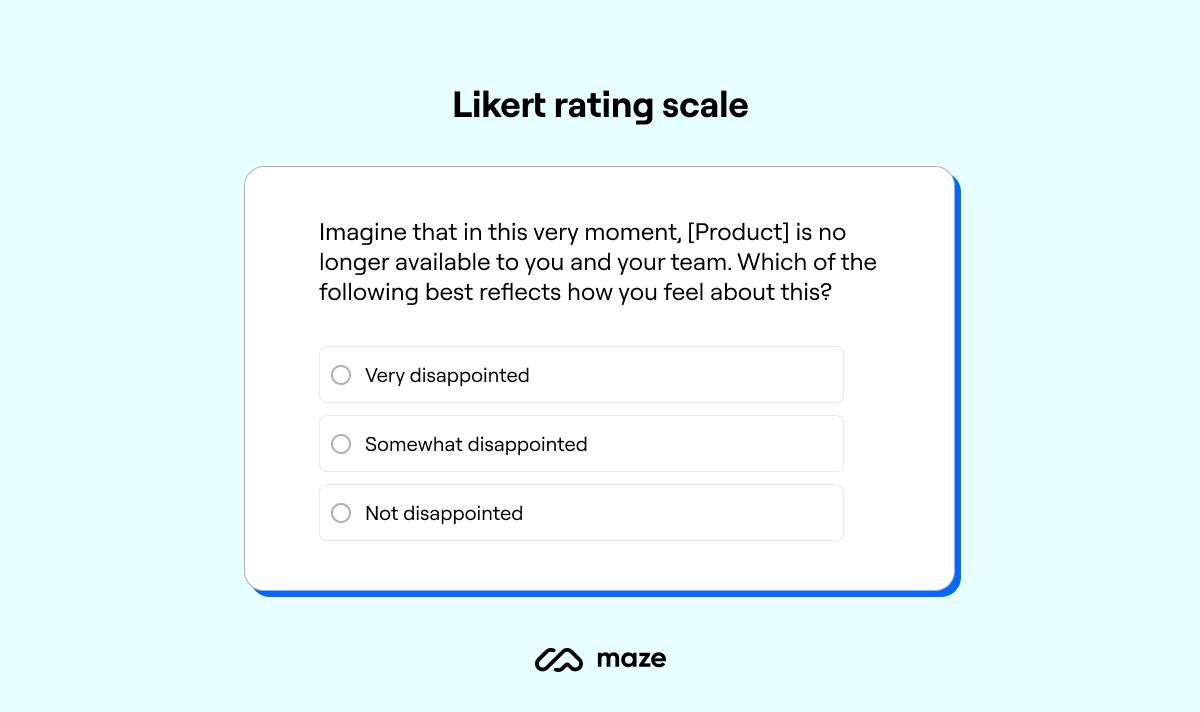
Likert rating scale question from Maze
You can add open-ended questions to your CSAT surveys for deeper insights. For example:
- “Can you describe your overall experience with our product/service?”
- “What could we do to improve your experience with our product/service?”
You can also simply follow up with “Why?” following a Likert scale question to gather more feedback from customers on the reasoning behind their answers.
Net Promoter Score survey (NPS)
While conducting a CSAT survey gives a good grasp of customer satisfaction, it likely isn’t the only feedback you’ll need on customer expectations and experience. Net Promoter Score surveys help you understand customer loyalty, and give insight into whether certain customers need to be engaged to avoid churn.
NPS survey question examples
NPS surveys are remarkably easy to conduct because they typically only ask a single question:
“On a scale of 1-10, how likely are you to recommend (product/service/brand) to a colleague or friend?”
You then organize respondents into three segments:
- Your promoters, who score a 9 or 10, are your superfans
- Your passives, who score a 7 or 8, are just okay
- Your detractors, who score a 6 or under, are at risk of churning
NPS surveys are simple. However, you can still ask a range of open-ended, follow-up questions to gain deeper insights:
- “What’s your experience been like using [product]?”
- “What would you like to see more of from [company]?”
- “What would you like to see less of from [company]?”
Our advice is to always dig deeper—which is also why we developed Maze AI Follow-Up Questions. These dynamic questions adapt to previous answers and help you go beyond surface-level insights to delve into each participant’s unique responses—getting answers to the most crucial question of all: why?
By combining a scale question with open-ended questions, you’ll get the data you need to measure NPS and get context on how to improve your CX holistically.
Customer effort score survey (CES)
The last thing you want is for users to find your product difficult to use. By conducting a customer effort survey, you’ll gain insight into how easy or hard it is for customers to complete tasks throughout their user journey. This could be anything from the sign-up process, to raising support tickets, to using your product—any action or task they complete as customers.
An important consideration with CES surveys is that they should immediately follow the action or task you’re assessing. You want customer feedback directly after the fact—when the experience is fresh in their minds.
After conducting this survey, you can use the insights gleaned to identify which touchpoints need to be easier to use to create a smoother customer journey. After all, reducing customer effort helps increase customer satisfaction and customer retention.
CES survey questions examples
When running CES surveys, you can choose to focus on the overall experience or single out certain touchpoints, like customer support or completion of processes. Some questions you can consider asking in your CES survey include:
- “On a scale of ‘very easy’ to ‘very difficult,’ how easy was it to use our product/complete your transaction/resolve your issue?”
- “On a scale of no effort to a lot of effort, how much effort did you have to put in to use our product/complete your transaction/resolve your issue?”
- “Was using our product/completing your transaction/resolving your issue easier or harder than you expected it to be?”
You’ll typically be providing a Likert scale for customers, but you can also opt for emoji scales to simplify the process for users. The goal is to make it as easy as possible for them, to increase the likelihood of getting responses.

Graphic rating scale from Maze’s feature usability survey template
In fact, that’s how you should approach all your CX surveys—whether you’re running a CSAT, NPS, or CES survey. Getting customers to engage with surveys is half the battle—making them easy to respond to is crucial for securing responses.
💡 Check out our article on how to encourage customer participation in feedback initiatives.
How to create a customer experience survey in five steps
You’ll find a lot of different advice on creating customer experience surveys, but it all ultimately boils down to these five steps.
1. Define your objectives
Start by asking yourself what you hope to achieve with your customer experience survey. Do you need insight into what customers think of your sign-up process? Are you looking to see if customers find it arduous contacting the customer care team? Do you want to know what customers love about working with you? Your objectives should guide your survey, and they should be informed by your broader CX strategy.
The key here is focusing on one main goal, as it will dictate which CX survey you create. Rather than trying assess everything, be as specific as possible, for example: “I want to assess customer satisfaction with the customer support process.” rather than *“I want to see what customers think of our product.” *
2. Choose your survey type
After you’ve outlined a main objective, it’s time to settle on a CX survey type. Consider the goal of your CX research and how you can structure your survey to uncover the insights you want.
Using our above example of assessing satisfaction with the customer support process, you could consider a CSAT survey. You might also choose to run a CES survey to get feedback directly following an interaction with customer support. It’s not specifically a satisfaction survey, but if customers find working with your support team difficult, it’s not the biggest leap to conclude that they’re dissatisfied with the process.
We said it before and we’ll say it again: you know what you’re looking for, so build the survey that helps you find it. Feedback surveys are a malleable research method, and the right UX survey tool is flexible—you should be able to adjust structure and questions as you need to ensure you get relevant feedback.
3. Write your CX survey questions and distribute your survey
With your objectives outlined and survey type chosen, you can move on to writing the survey questions you’ll ask your customers. These questions depend on what you’re trying to uncover, but going off our example, consider:
- “How would you rate your experience with our Customer Support team?
- “Very poor
- “Poor
- “Acceptable
- “Good
- “Very good”
- “Can you describe your experience with the Customer Support team?”
- “How easy or difficult was it for you to solve your issue with the Customer Support team?”
The biggest thing to watch out for at this stage is leading questions. They’re a sure-fire way to get biased responses that lead to unreliable insights.
Not sure where to start with survey questions?
Check out our open-source Maze Question Bank, filled with 350+ research questions for your customer experience survey. Best of all, it’s totally free.
4. Recruit customers for your survey
Once you’ve written or selected your questions, you’re ready to distribute them to your participants through the relevant channels. Consider how customers interact with your brand: email, the Support team, and in-product pop-ups are all ways to reach your target audience.
If your survey is focused on a feedback around specific action or task, consider recruiting in-product or setting up an automated recruitment email that can target customers who fulfill the criteria. Alternatively, you can use tools like the Maze Panel to reach a broader base and recruit research participants for customer experience surveys that don’t require any prerequisite tasks.
5. Analyze the results
Survey analysis is where most of the magic happens. Through analyzing your responses, you’ll turn raw survey data into actionable insights—which you can use to improve CX and make better decisions across your organization.
You’ll get two types of data from CX surveys: quantitative data and qualitative data.
Your quantitative data will come from rating scale and close-ended questions. For example, looking back on our previous question: “How would you rate your experience with our Customer Support team?”.
You might find that 83% of users rated their experience as ‘good’ or ‘very good’. This is quantitative data that you can use to quickly and easily evaluate your performance—both against competitors and against your own previous scores.
Your qualitative data comes from open-ended questions, like our previous example of: “Can you describe your experience with the Customer Support team?”.
For open-ended questions, you can looking at thematic analysis to extract phrases and customer sentiments that regularly appear in your survey results.
Once you’ve got your results, you can use your findings to:
- Inform stakeholders on the state of customer experience
- Conduct further research based on the insights you uncovered
- Resolve common customer experience issues customers discussed
- Ensure customer-centric decision-making across the entire organization
However you use them, the valuable insights collected from customer experience surveys are crucial for understanding customers and optimizing their experience with your brand. Happy customers stick around, disappointed customers don’t—it’s as simple as that.
💡 Want quick, digestible reports on your CX survey results to share with your team and stakeholders? Maze Reports are automatically generated following your user research studies.
Customer experience survey templates
If you don’t feel like building a customer experience survey from scratch, there are tons of efficient tools to speed up the process. If you’re short on time, you can also look to customer survey templates to speed things along—here’s our top three.
CSAT template
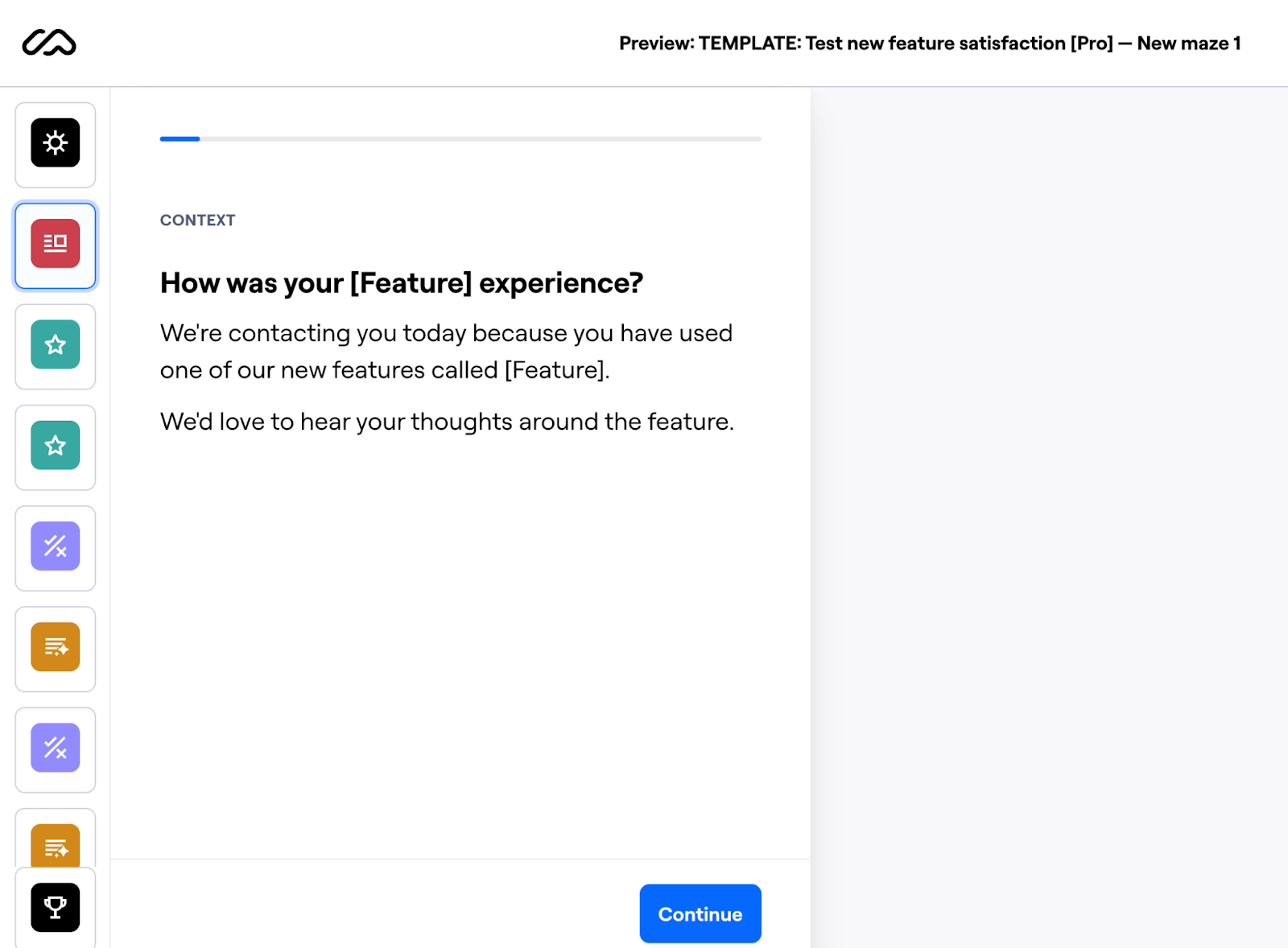
Using this customer satisfaction survey template, you’ll be able to quickly identify customer pain points, giving you feedback for future CX design improvements. It features a range of questions designed to uncover exactly how satisfied customers are and why. Some of the question types include opinion scales, yes/no questions, and open questions—as well as context screens to provide any necessary information.
NPS survey template
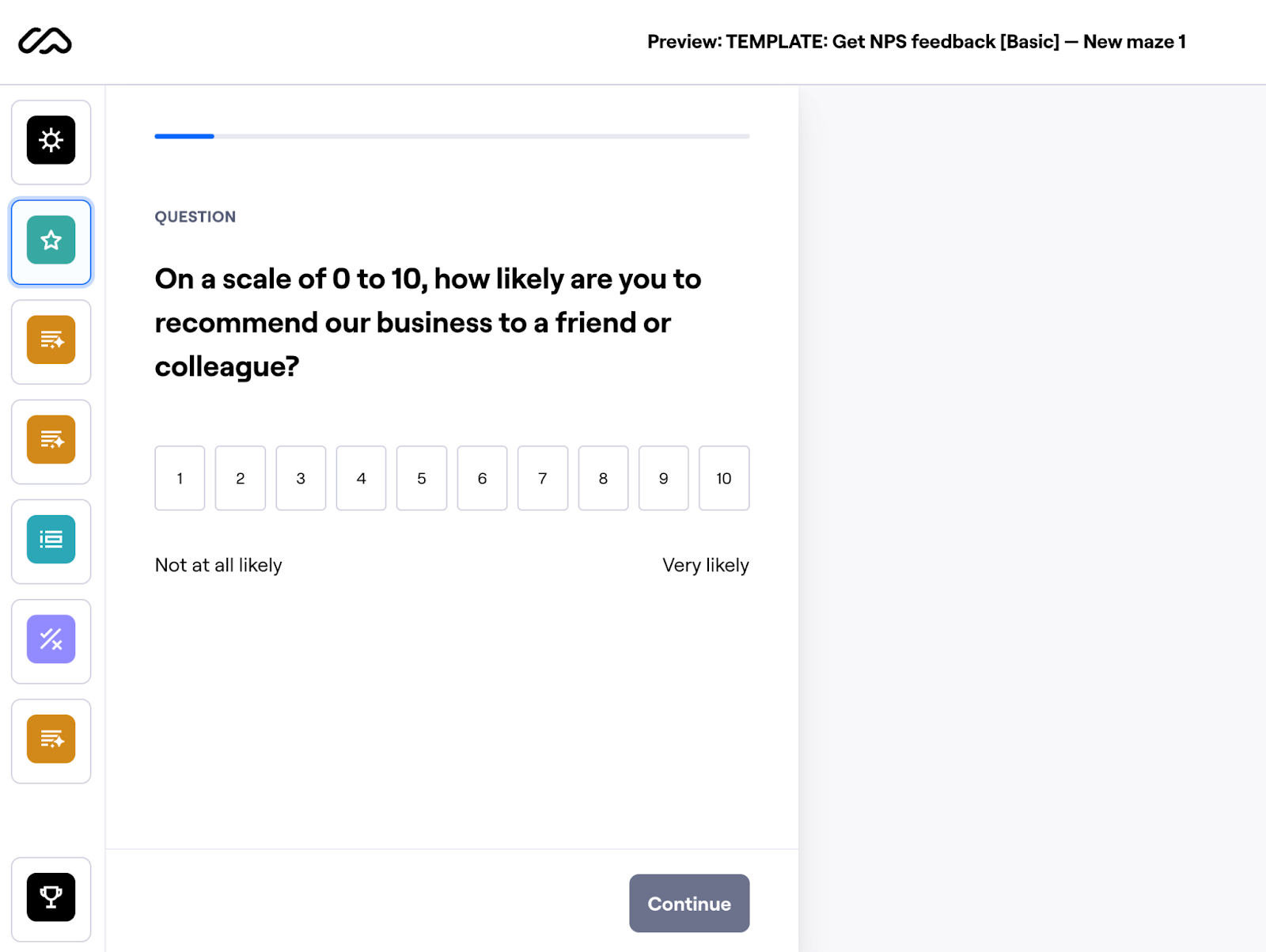
This NPS survey template asks how likely the customer is to recommend your product to their network, then follows up with a range of multiple-choice and open-ended questions for additional context. It picks up on not just your customers' opinions, but the reasoning behind them.
CES survey template
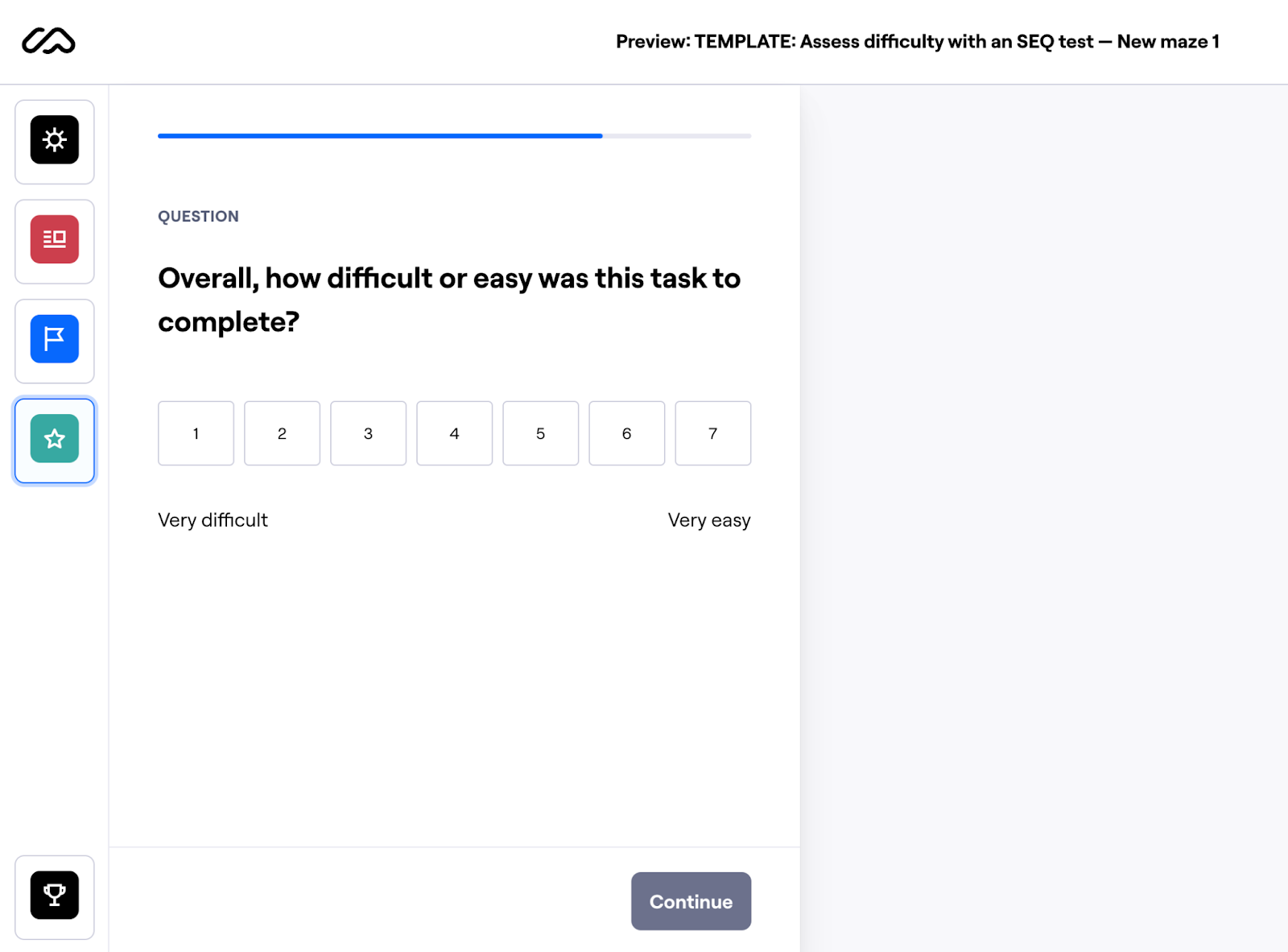
While this looks at the effort expended on a usability test, with a few quick changes you can fine-tune the questions to hone in on how much effort customers are putting into completing CX-related actions and tasks. With both multiple-choice questions and open-ended questions, you’ll be better equipped to understand how to make intuitive, feedback-driven design choices.
Get customer experience feedback with Maze
Customer experience surveys are a useful way to understand and evaluate what your customers think about their journey with your business. Your goal should be to build a holistic customer experience based on the insights you uncover from customer feedback.
Creating and analyzing customer experience surveys shouldn’t be hard, and with the right tool—it isn’t. Maze’s feedback and satisfaction surveys streamline your feedback collection process so you can focus on making the changes your customers want to see. Plus, with Maze, you also get access to various other UX research methods—like usability testing, interview studies, and much more.
Don’t wait until customers start churning to collect feedback on CX; speak to customers now to preempt problems—or you may just find you’re left with no customers to survey.
Recently asked questions about customer experience surveys
What are customer experience questions?
What are customer experience questions?
Customer experience questions are questions you can use in CX surveys, interviews, and other research methods to gain insight into your customer’s experience across multiple touchpoints. They can be rating scale questions, close-ended questions, open-ended questions, and more.
How do I write great customer experience surveys?
How do I write great customer experience surveys?
To write great customer experience surveys—and ensure a high response rate—keep some survey question best practices in mind. These include avoiding biased and leading questions, keeping surveys short and sweet, using incentives for respondents, and testing before sending your surveys to customers.
How do I ensure I reach the right audience with my customer experience survey?
How do I ensure I reach the right audience with my customer experience survey?
When attempting to reach the right audience for your survey, be sure to deploy it to customers who regularly use your product or the particular feature you’ll be asking them about.



